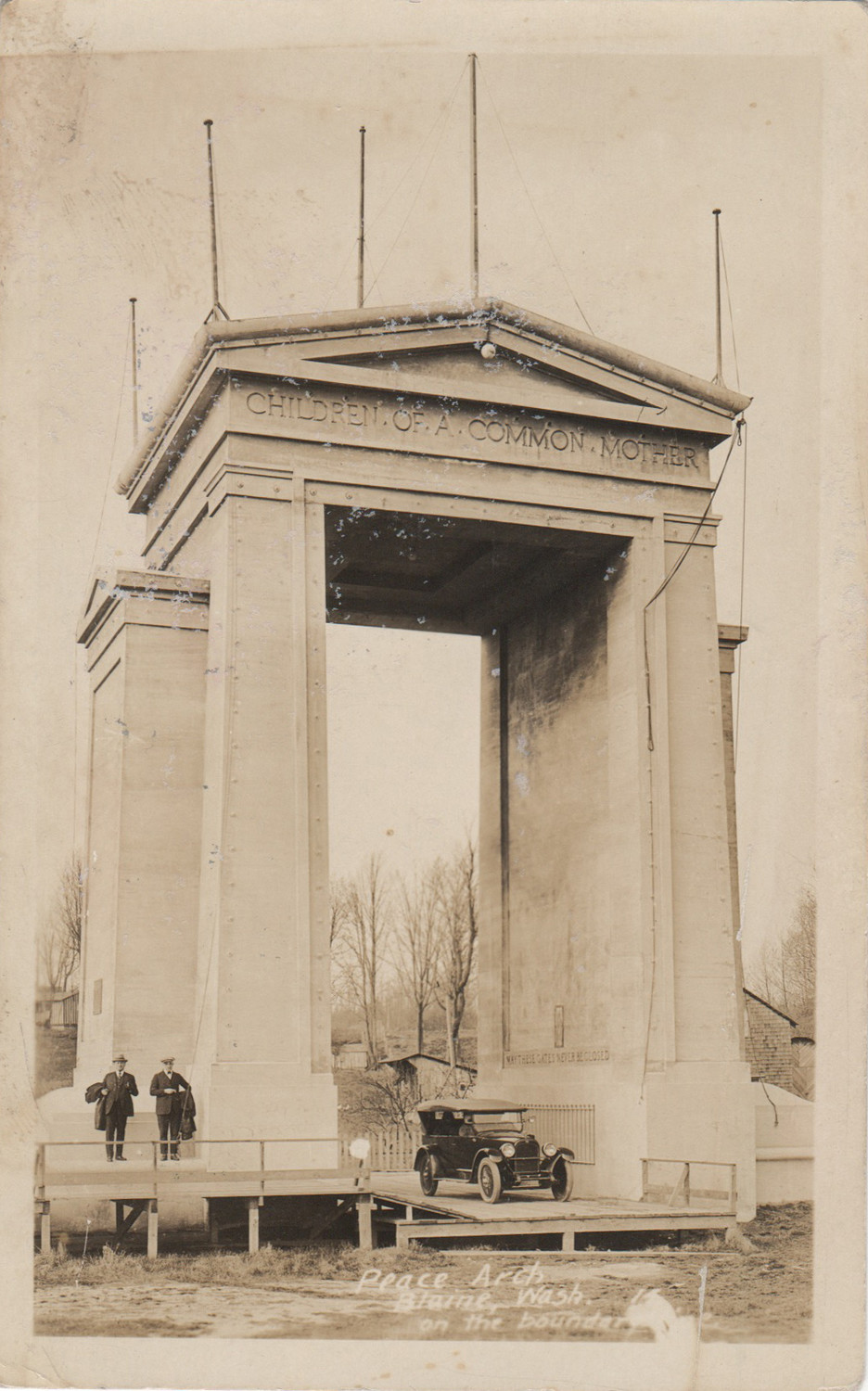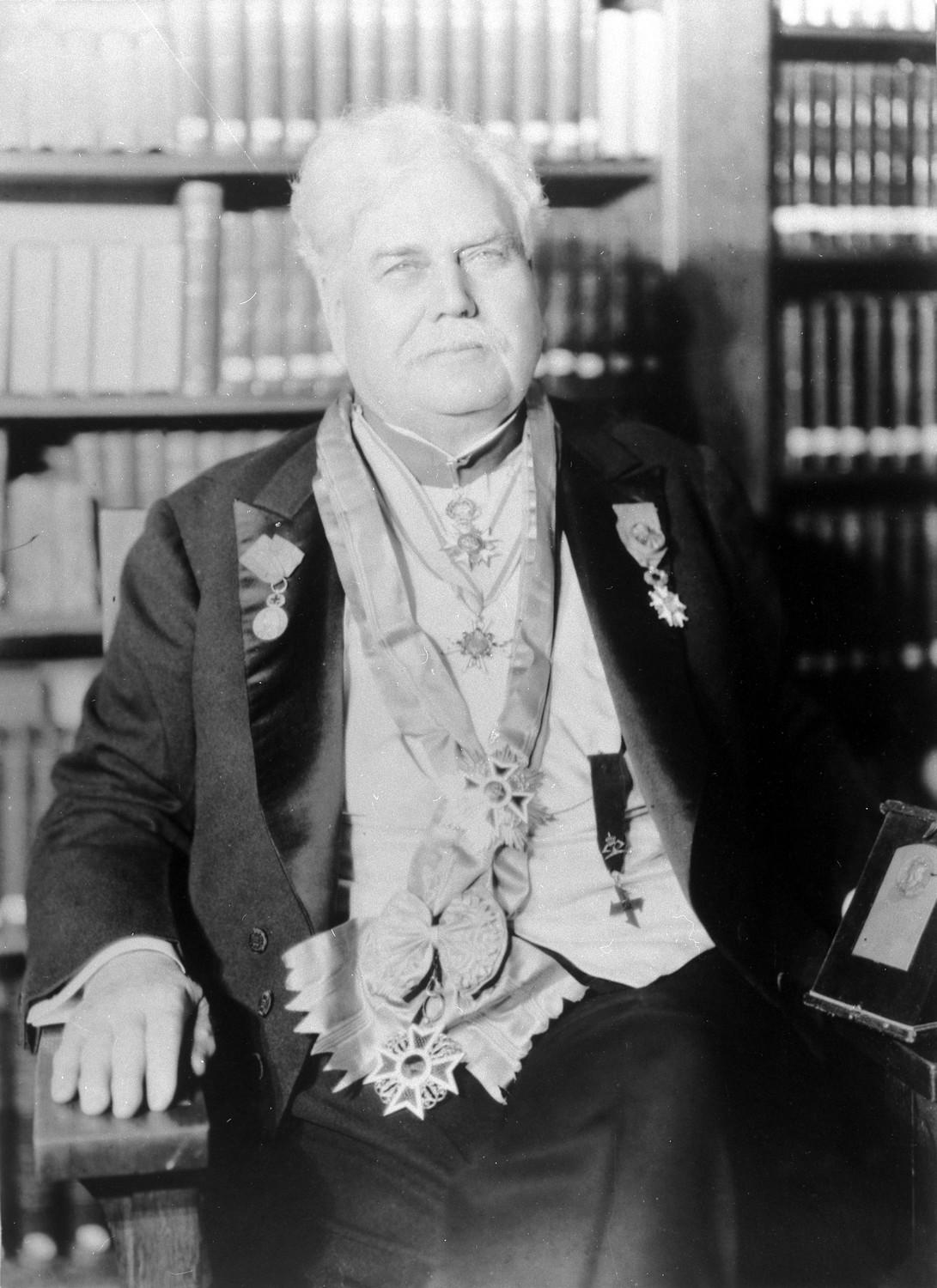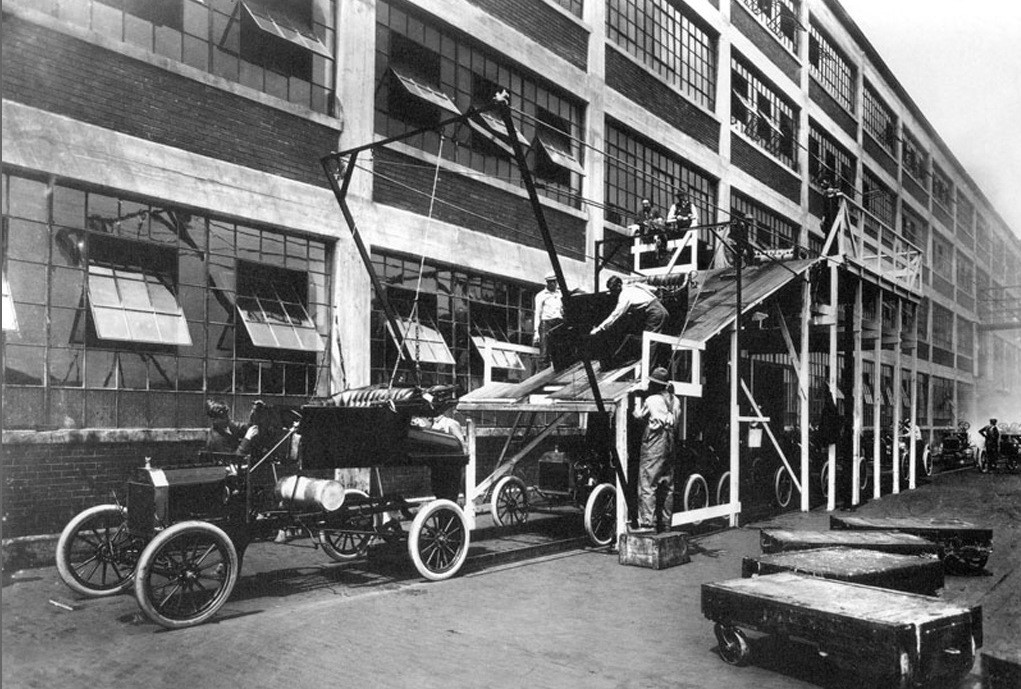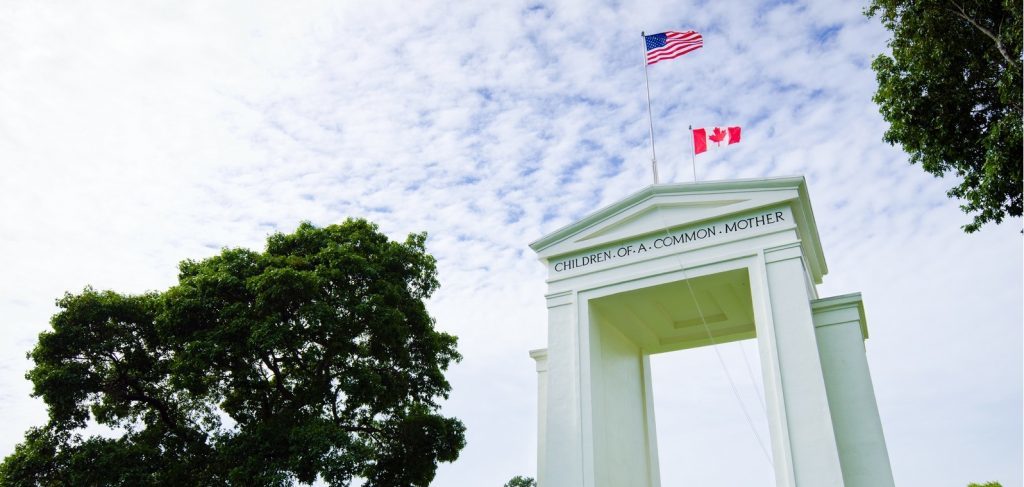On this day, September 6, 1921, American road builder Sam Hill made his way through a throng of 15,000 flag-waving dignitaries, citizens and schoolchildren gathered along the international border-crossing between the U.S. and Canada in Blaine, Washington. The crowd edged forward as Sam, the headliner of the celebration, mounted the wooden platform and ceremoniously laid the final cornerstone at the foot of a towering shrine to peace: The International Peace Arch.
It was a moment that brought together new developments in technology, a sense of history and the defining issues of the day. Sam had financed and managed the construction of the 8-story steel and concrete portal, which commemorated the signing of the Treaty of Ghent, the peace accord that ended the War of 1812 between the United States and Great Britain. Known initially
as “Sam’s Peace Arch,” the majestic monument was perched at the intersection of the newly built Pacific Coast Highway and the 49th Parallel, the longest unfortified and undefended international border in the world.
“War satisfies neither the victors nor the vanquished,” Sam told the crowd. “Perfect peace alone satisfies.” His poetic words, delivered when the world was recovering from the ravages of the Great War, triggered a roar of applause from both sides of the border. One local reporter captured the departing crowd’s mood, deeming the day “one of the great events of the century.” It was a day that was many years in the making.

War satisfies neither the victors nor the vanquished
While Sam may have financed and built the arch, it was a vision he shared with his Canadian friend, the former Mayor of Victoria B.C., Alfred Todd. After returning from a trip to the Mexican border, Alfred recognized that in a time of tenuous international relations to America’s south, the ties between the United States and Canada were not just different, but exceptional. The two individuals had partnered for more than seven years to memorialize this harmony with a gleaming arch that would serve as a “portal of peace” between the two nations.
While enduring peace was Sam and Alfred’s shared passion, the Peace Arch, as well as the Pacific Coast Highway that travelers motored to reach the celebration, wouldn’t have been possible without Sam’s progressive vision and dogged pursuit of a road system – and roadway technology – connecting the Pacific Northwest.

As the former president of Minneapolis’s Great Northern Railway, the rails of Sam’s company had helped open the West to settlers. He had followed the lines as they extended towards the Pacific Ocean and in 1899, he made Seattle his new home. At the time, Seattle lacked paved roads and the unforgiving rain meant the town was stuck in the mud. Roads were mostly livestock trails, and the region’s entire economy relied on boats and railways.
As the twentieth century arrived, the automobile was rapidly becoming more than a novelty. By 1904, American automobile manufacturers produced 22,130 vehicles, becoming the world’s largest producer of cars.[1] With
relatively high purchasing power and falling price tags, thanks to new production practices, car ownership in the United States swelled. But while American factories pumped out cars, motorists were frustrated by dreadful – and often nonexistent – roads.

As the twentieth century arrived, the automobile was rapidly becoming more than a novelty. By 1904, American automobile manufacturers produced 22,130 vehicles, becoming the world’s largest producer of cars. [1] With
relatively high purchasing power and falling price tags, thanks to new production practices, car ownership in the United States swelled. But while American factories pumped out cars, motorists were frustrated by dreadful – and often nonexistent – roads.
Car ownership rapidly expanded around the world and Sam saw a future for the region built upon interconnected roads transporting goods and people. At the time, 93 percent of the nation’s roads were unpaved. He knew that good roads were the path to economic development and prosperity, and he turned his focus away from railways to roadways and championed the creation of good roads.
Sam immersed himself in the study of sophisticated European road systems and experimented with new paving materials. In 1899 he invited business leaders from across the region to Spokane, Washington to recruit supporters of his vision. The Washington State Good Roads Association was born.
In 1905, Sam successfully lobbied the Washington state legislature to organize a state highway department and soon after, he convinced the University of Washington to establish the nation’s first chair of highway engineering. Before long, Sam presided over the Pacific Highway Association and began work to create a “national auto trail” extending from Vancouver, British Columbia to Tijuana, Mexico. Over the years this major route – known today mostly as Interstate 5 – would become a “chain that binds the West.” [2] The Good Roads movement was gaining momentum.

When the United States entered World War I in 1917, private car ownership waned as manufacturing shifted to support the war effort in Europe. Automobiles proved more reliable than horses on the battlefield, playing essential roles in resupplying, scouting, couriering and evacuating troops.
The automobile industry rapidly responded to military demands. Ford Motor Company alone supplied Allied Forces with 125,000 Model Ts, which were durable, easy to repair and well-suited to traverse rural battlefields. The war demanded long-distance trucks, and manufacturers responded by converting car chassis to truck bodies. In the United States alone, truck manufacturing grew from 24,9000 vehicles in 1914 to 128,000 in 1917 – producing more trucks in a month than in any prior year.[3]
Almost 100 years later, the issues and technologies that led to the inauguration of the Peace Arch speak to us in multiple ways.

When the Treaty of Versailles was signed in 1919, automobile technology and manufacturing capacity had greatly advanced and the industry was primed to meet the pent up demands of America’s wannabe motorists.
What the country lacked was a highway system to support this new mode of transport – a point General John Pershing, commander of U.S. troops in Europe, proved when he organized a convoy of 79 trucks to travel from Washington D.C. to San Francisco in 1919. Poor road conditions plagued the journey, which averaged a mere 55 miles a day and took 56 days to complete.[4]
The war effort ironically became the catalyst for the passage of the 1921 Federal Highway Act. Signed just two months after the dedication of Sam’s International Peace Arch, the Act paved the way for Sam’s vision, and over the next decade interconnected freeways began crisscrossing the continent.
Almost 100 years later, the issues and technologies that led to the inauguration of the Peace Arch speak to us in multiple ways.
As autonomous vehicles become the talk of our future, Sam’s experience reminds us that the practical utility of cars is inextricably based on the quality of the roads on which they travel. There are now more than four million miles of public roads in the United States, a huge achievement.[5] But we doubt that Sam would be impressed by their present condition. One out of every five miles of our federal highways currently are in poor condition.[6] And a whopping 56,000 bridges – 9.1 percent of the total – are considered structurally deficient.[7] The poor conditions of our roads and bridges slow traffic and create real risks for health and safety.
The solution lies in part in new investment. That’s why new federal infrastructure initiatives are so important, including a planned infrastructure proposal this fall from the White House.

But as in Sam’s day, the future of roads is also about the future of new roadway technology. And the future of this technology is again ripe with innovation. Companies from Qualcomm to start-ups are testing the use of metal coils embedded in asphalt to charge electric vehicles as they drive over them.[8] Others are working on initiatives to enable smarter cars to exchange information with smarter roads.[9] And new research is paving the way – literally – for technological advances to better preserve asphalt itself, given its still fundamental role on the nation’s roads.[10]
There’s a second aspect that’s important as well. As in Sam’s day, roads are all about connecting people with each other. He and Alfred Todd saw the potential for growth and jobs that could come from better connections up and down the Pacific Coast, starting in Vancouver and moving south to places like Seattle and Portland. That spirit is now advancing in new ways as well.
Here in our corner of the continent, government, community and business leaders from across British Columbia, Washington state, and Oregon are joining together to shrink the boundaries that divide us and creating greater economic opportunity for our entire region. We call it the Cascadia Innovation Corridor, and last year, citizens and leaders from both sides of the border met in Vancouver B.C. to explore the common strengths, challenges and shared stewardship of the land that make this part of the world so special.
We will continue this conversation at this year’s meeting in Seattle. The region is building on Sam Hill’s foundation, bringing the public and private sectors together to invest in new innovations, promote education and research, transform existing industries, and make sure everyone in our communities can take part in the new opportunities we create.
But there’s a third part of the Peace Arch’s story that is the most powerful for us, and it makes this day particularly fitting to remember given the events of our own day. As we look to the south today, the news is filled with the controversy around building an even higher wall on the border with Mexico. As we look across the Pacific, the news is dominated by even greater tensions on the Korean peninsula
– divided by a demilitarized zone and border that is fortified on each side with tanks, artillery, and troops. While Sam Hill was passionate about roads, he knew that the most important “highway” was not the one uniting, but dividing the United States and Canada. He called the border the “Highway of Peace,” the 49th Parallel that serves as the invisible boundary stretching 2,175 miles between the Canadian provinces of British Columbia, Alberta, Saskatchewan and Manitoba to its north, and the states of Washington, Idaho, Montana, North Dakota and Minnesota to its south. As Sam inscribed on the top of his Peace Arch, the undefended border that divides the United States and Canada is a symbol of our strong bilateral relationship: “Brethren Dwelling Together in Unity.”
Like the border itself, the Peace Arch remains extraordinary. It’s the central point of a park that sits between the immigration and customs checkpoints of each nation, but can also be visited by exiting the highway without entering the other country. As one stands next to the Arch, one gazes across the glistening salt water of Boundary Bay, at the unbroken string of San Juan and Gulf Islands, and towards the majestic mountains of Vancouver Island.

While the park is at a major international border, it’s sponsored by the BC and Washington provincial and state governments, rather than the national government of either nation. And like the Arch itself, the park was built by local communities and is supported by local volunteers.
For the last quarter-century, no volunteer has been more important than Christina Winkler, the founder and President of the International Peace Arch Association. She sees the reactions of visitors to the park and notes that there are “some people who come here from somewhere else in the world who are just absolutely in awe at what we have here, and have never experienced anything like it.”
we are some of the most blessed people in the world to have such great neighbors. You can say that from either side
As Christina says, “we are some of the most blessed people in the world to have such great neighbors. You can say that from either side.”
While the Peace Arch may sometimes not get much more than a glance from the 4,000 motorists who stream by in both directions each day, the unbroken peace it symbolizes between our two countries wasn’t a given for Sam Hill and his contemporaries. A century later, the Arch provides a visible and powerful reminder that good neighbors should not be taken for granted.
Today in Technology is a series that highlights important technology developments from the past and discusses the insights they offer for the tech trends and issues of our own day.
[1] Rudi Volti, Cars and Culture: The Life Story of a Technology (London: Greenwood Press, 2004), 21.
[2] Richard Clark, Sam Hill’s Peace Arch (Bloomington, Indiana: AuthorHouse, 2006), 13.
[3] Volti, Cars and Culture, 46.
[4] Ibid.
[5] U.S. Department of Transportation, Federal Highway Administration, 2015 Status of the Nation’s Highways, Bridges, and Transit: Conditions & Performance (January 2017), xxxviii. https://www.fhwa.dot.gov/policy/2015cpr/pdfs/2015cpr.pdf
[6] Ibid., at 3-3.
[7] American Society of Civil Engineers, 2017 Infrastructure Report Card: Bridges, at https://www.infrastructurereportcard.org/wp-content/uploads/2017/01/Bridges-Final.pdf
[8] Futuristic Roads May Make Recharging Electric Cars a Thing of the Past – June 1, 2017, https://www.nbcnews.com/mach/mach/futuristic-roads-may-make-recharging-electric-cars-thing-past-ncna766456
[9] The V2I Deployment Coalition focuses on “Vehicle to Infrastructure,” or “V2I” technology, and is bringing together state departments of transportation, research universities, and many others to pursue a connected, safe and secure transportation system that can take full advantage of progress with connected cars and autonomous vehicles. https://www.transportationops.org/V2I/V2I-overview
[10] See National Center for Asphalt Technology at Auburn University, “Research Findings Attract Record-Setting Attendance at NCAT’s Test Track Conference,” Asphalt Technology News (Volume 27, Number 1) Spring 2015, at https://eng.auburn.edu/research/centers/ncat/info-pubs/newsletters/atnspring2015.pdf









